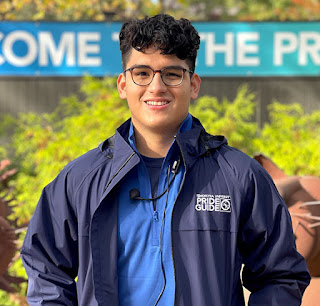Reflections On My Journey to Hofstra from a Socio-Economic Perspective by Miguel Giral
“Why not?” The question I always ended up asking myself every time I left my high school guidance counselor’s office. Why was it that Hofstra was a school that I had to forget about or move to the side, or categorize as a “reach” school? The effort I put into doing well in all of my courses, the time that I spent in clubs and at practice and games, the relationships I built with teachers, and faculty to have the best opportunities for solid recommendation letters were all not good enough for this school all of a sudden.
Well, that’s what I thought. Silly of me not to realize that it was not because of my transcript or personality or anything that had to do with me personally. I just could not afford it, along with most of my friends in high school. I was a minority student living in a neighborhood where although I had everything I could ever wish for and more, it is not typical to afford a school as expensive as Hofstra.
The students I surrounded myself with were all high-caliber students in and out of the classroom. However, most of us ran into the same issue. Hofstra was simply out of our budget and not a school that seems to be designed for students with lower available tuition money and who come from different backgrounds. Although I have been lucky enough to have never faced acts of racism or classism directly and especially not in the classroom, it still feels like the system that the world has been set up with is against me.
Thankfully, I was able to apply for Hofstra’s New Opportunity At Hofstra (NOAH) program, which allows students of lower socioeconomic status to apply to the university and get a degree with more financial help. This program allowed me and my fellow NOAH classmates to put money aside and be represented by our abilities to perform at the same level or most of the time higher than other students who could easily afford the school. NOAH helps us temporarily put money aside and lets us start at the same level playing field as other fellow Hofstra students. Hofstra University, however, is not the only private school that is coincidentally predominantly white when it comes to its student population and faculty. Hofstra, for instance, is comprised of roughly 6,100 undergraduate students, of which more than 55% are Caucasian. The rest of the students’ ethnicities percentages decrease significantly with roughly 13% Hispanic students, 11% Asian students, 9% black, and the rest are of mixed multi-cultured ethnicities. Even with all the students of color combined, white students make up the majority of the population.
Two of the biggest factors that impact diversity on campuses nationwide are income and tuition. Without the help of scholarships, grants, or athletic-related funding, the numbers are quite correlated. The higher the income of a family, the more likely their respective children will attend schools with higher tuition. Most of the time, higher tuition includes better facilities, access to information, food, recreational centers, classrooms, libraries, dormitories, events, and so on. Like most things in life, the more it costs the better it will be and so will the experience. Whites have an average household income of over $61,000 Hispanic households at slightly more than $50,000, and Black households with $40,000; the pattern that follows is that the white households will be able to pay more for school than their minority counterparts. This does not only occur at the college level but in most private K-12 schools in this country, the numbers are quite similar if not worse. Of all the students that attend these schools, the large majority of students are white and take up roughly 67% of the population. Hispanic, black, and Asian students make up 11%, 9%, and 6% respectively.
The idea of a system where students of all colors and ethnicities can sit in the same classrooms as the students in the neighborhood next to them may seem far-fetched, but that’s the dream. A system where the tuition of an institution is not enough to dissuade potential students from attending Red-lining, gerrymandering, lower-income homes and schools and neighborhoods, and internally racist realtors and biased guidance counselors won’t disappear overnight, but as more people learn about the blatant disparities between schools and students, there will be hope for change.
Miguel Giral is a junior, part of the NOAH program, and serves as a Student Fellow at the Center for “Race,” Culture and Social Justice.



Comments
Post a Comment